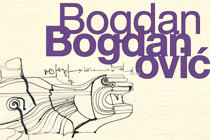
|
Bogdan Bogdanović. The Doomed Architect 05.03 – 02.06.2009 INFORMATION FOR THE PRESS Press Conference: Wedneseday, Mar. 05, 2009, 11:00 am Opening: Wedneseday, Mar. 05, 2009, 07:00 pm "The urban researcher and town walker, architect, sculptor, ornamentist and calligrapher, the graphic designer and 'scribbler', the mythologist, etymologist, raconteur and writer of high calibre, yes, the ex-Jacobin, ex-Trotskyist, perpetual Gnostic and deist, the one-time politician, although an enormously political individual throughout his life, the surrealist repeat offender, provocative lateral thinker and philosopher, and not least the great teacher without a doctrine, who performed with all of his talents. The phenomenon of Bogdan Bogdanović is more than the sum of its parts, and probably inaccessible in any form to a purely analytical thinker." Friedrich Achleitner MONUMENTS AND MEMORIALS Bogdan Bogdanović, born in 1922 in Belgrade, was not only the leading and most preeminent monument architect in the multi-ethnic former state of Yugoslavia, but he was also an unconventional urbanologist, essayist, writer, philosopher and much more. Bogdanović can look back on a political career, too: he was Mayor of Belgrade from 1982 to 1986. The quotation from Friedrich Achleitner illustrates the sheer diversity of Bogdanović's talents. Between 1951 and 1958 Bogdan Bogdanović completed 19 memorial sites in many parts of former Yugoslavia as a symbol against war and persecution. Bogdanović decided on a culturally universal architectural vocabulary, free of ideological insignia. The tireless draughtsman developed new forms for each of the locations — always in a dialogue with the local conditions. None of the 19 memorial sites is like another, each is unique in itself. In his view of himself as a "builder" it was very important to him to work on the different monuments in a kind of work-in-progress in a close dialogue with the stonemasons. His poetic and pathos-free treatment of sites of destruction culminated, above all, in the Jasenovac flower, which stands on the site of what was once a concentration camp. The Partisans Necropolis in Mostar/Bosnia-Herzegovina as well as the Commemorative Cemetery for the Victims of Fascism in Sremska Mitrovica/Serbia number among the most important of the memorial sites. "What I was capable of was recoursing to archaic forms. I was convinced that the deeper the semantics of form went into the meta-historical layers of the human imagination, the more readily understood the symbols would be." (Translated from: Der verdammte Baumeister) TEACHER AND WRITER Bogdan Bogdanović taught for 35 years at the architecture faculty of Belgrade University, and was very early to launch the course on urbanology. Not merely concerned with urban development, also, and key were the origins and the metaphysics of the town, which provided the focus of the course. In the 1970s he went a step further and founded the Village School for Architecture Philosophy near Belgrade, where he ran alternative workshops and, by no means least, in this context he can be described as an ‘architecture esoteric or architecture philosopher’. Bogdanović grew up in a house where the written word was held in high esteem. So he soon began to work as a theorist, and wrote a series of architecture books with a poetic touch. In his first work, Small Urbanism written in 1958, he supports the perspective of the individual as the scale for all urban development interventions. In principle, he was engaged in the creation of an architecture that would issue from language: "I wrote so that I could build, and built so that I could write." Some of his writings have been translated into German, however not into English yet. THE EXHIBITION The monographic exhibition has four sections. The largest section is devoted to the monuments, of which all 19 are on show. Bogdanović also addressed housing during his career, among other things — two of his houses are presented in their own area. The third and fourth sections of the exhibition bring us closer to Bogdanović as a writer and a teacher. On the basis of photographs, drawings, film footage and text, the exhibition embraces the visitor as an ensemble of suspended, hovering elements designed by the architects BWM Architekten und Partner. In 2005 Bogdan Bogdanović has made a living donation of his archives of drawings to the Architekturzentrum Wien. The collection contains over 12,500 works by the architect, including both architectural designs as well as numerous sketches and drawings. Now, for the first time, it is possible to show the modus operandi and thinking of the 'architecture philosopher', and to exhibit them in a comprehensive presentation. Bogdanović has been living in Vienna with his wife since 1993. The exhibition is accompanied by a catalogue Bogdan Bogdanović. Memoria und Utopie in Tito-Jugoslawien, as well as issue 42 of the Az W journal Hintergrund (both in German). Curator: Ivan Ristić Project coordination: Monika Platzer Exhibition architecture: BWM Architekten und Partner Publication: Bogdan Bogdanović. Memoria und Utopie im Tito-Jugoslawien Wieser Verlag, Klagenfurt Published by: Architekturzentrum Wien Graphic design: Gabriele Lenz German edition The Az W receives grants from: Geschäftsgruppe Kultur und Wissenschaft, Wien / Geschäftsgruppe Stadtentwicklung und Verkehr, Wien / The Austrian Federal Ministry for Education, the Arts and Culture The Az W is supported by: Architecture Lounge |
 |
|
© Architekturzentrum Wien |
|
Press page Current events Past events Gallery: Images for the Press: The Exhibition Images for the Press: Bogdan Bogdanović Images for the Press: Opening event Dates: Bogdan Bogdanović Downloads: Information for the Press: Bogdan Bogdanović Biography Bogdan Bogdanović Links: Wieser Verlag Information: Ines Purtauf Tel.: +43 (1) 522 31 15 - 25 Fax: +43 (1) 522 31 17 Email: purtauf@azw.at |
| © Architekturzentrum Wien 2025 |
||



